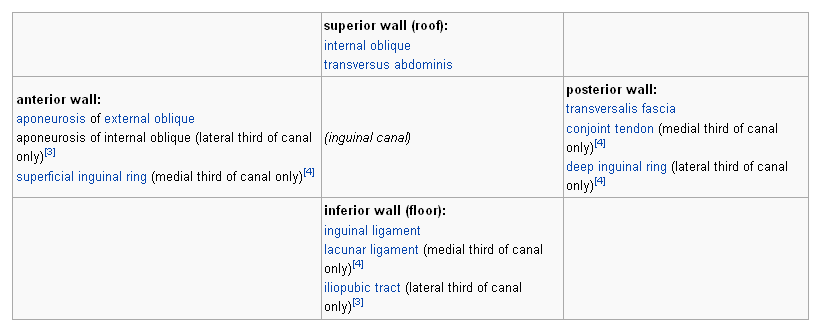Posted by jobinmartin on August 3, 2010

Visualize the canal as a cylinder, stretching from the deep inguinal ring to the superficial inguinal ring.[1]
To help define the boundaries, the canal is often further approximated as a box with six sides. Not including the two rings, the remaining four sides are usually called the “anterior wall”, “posterior wall”, “roof”, and “floor”. These consist of the following:
mnemonic “MALT”, starting at the top and going counterclockwise:
- M – muscles
- A – aponeuroses (The A in MALT coincides with the position of the wall – Anterior. Hence, it is impossible to mix up whether the direction of the mnemonic is clockwise or anticlockwise)
- L – ligaments
- T – transversalis/tendon
Contents
- in males : the spermatic cord and its coverings + the ilioinguinal nerve.
- in females : the round ligament of the uterus + the ilioinguinal nerve.
The classic description of the contents of spermatic cord in the male are: 3 arteries: artery to vas, testicular artery, cremasteric artery 3 fascial layers: external spermatic,internal spermatic,cremastic 3 other vessels: pampiniform plexus, vas deferens, lymphatics 1 nerve: genital branch of the genitofemoral nerve (L1/2)
The ilioinguinal nerve passes through the superficial ring to descend into the scrotum, but does not formally run through the canal.
Gonads (ovaries or testes) descend from their starting point on the posterior abdominal wall (para-aortically) and near the kidneys down the abdomen and through the inguinal canal to reach the scrotum. The testis then descends through the abdominal wall into the scrotum, behind the processus vaginalis (which later obliterates). Thus lymphatic spread from a testicular tumour is to the para-aortic nodes first, and not the inguinal nodes.
Source:Wikipedia

Leave a comment